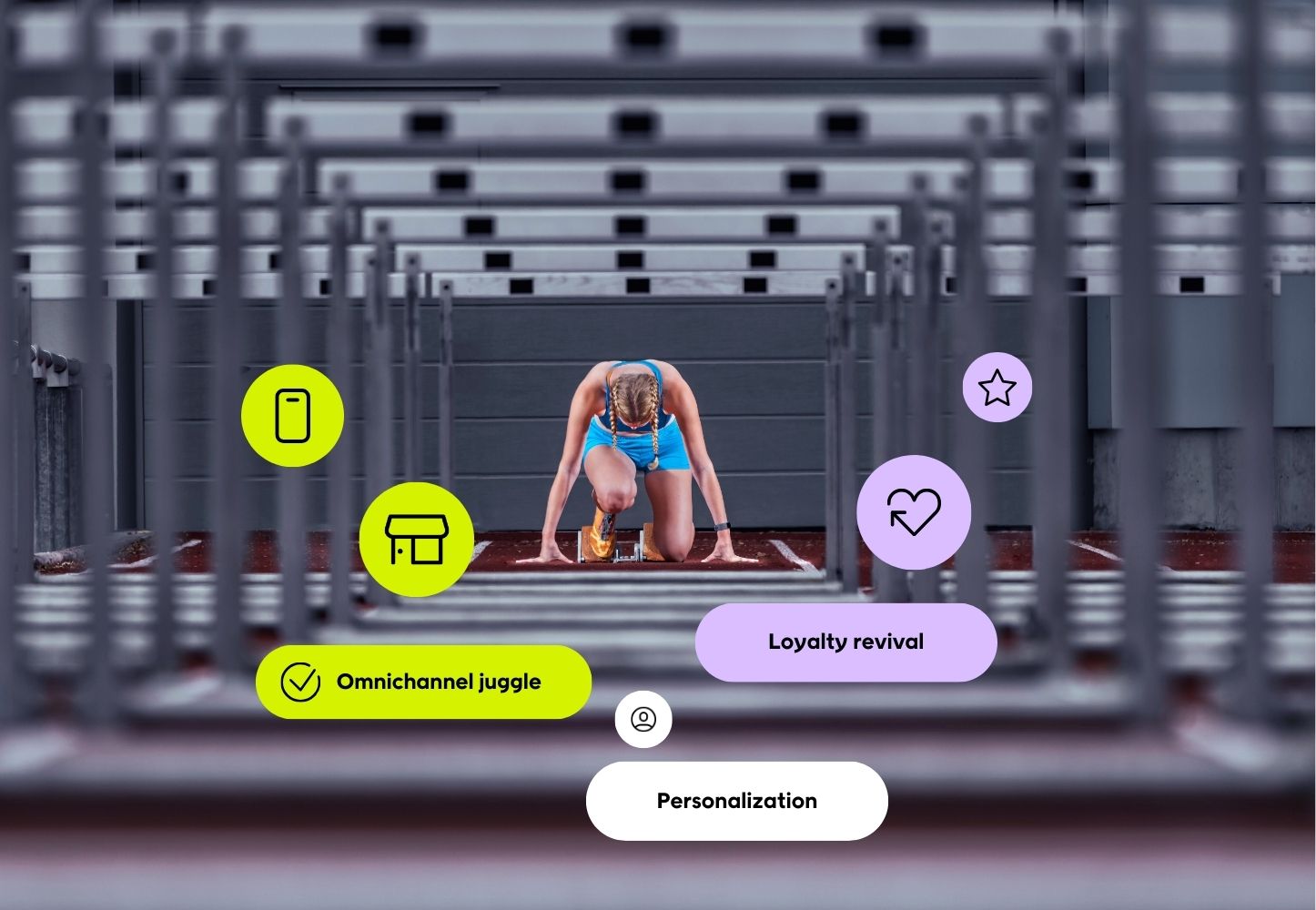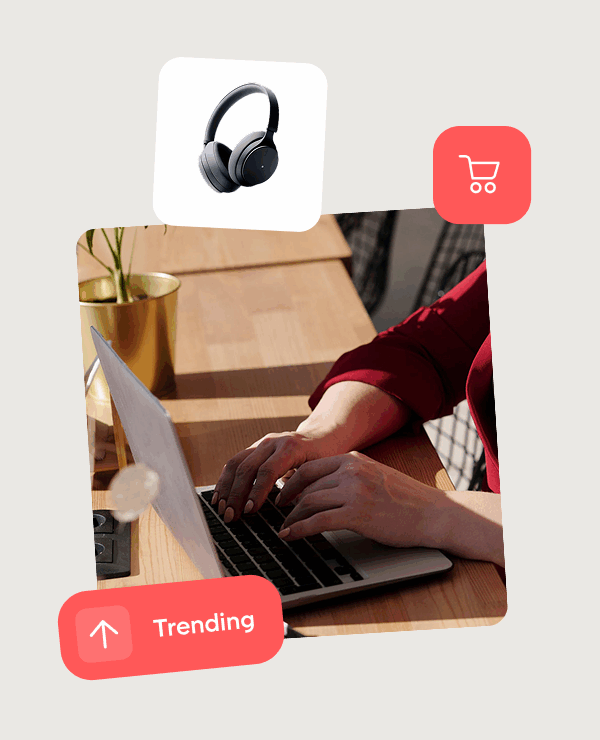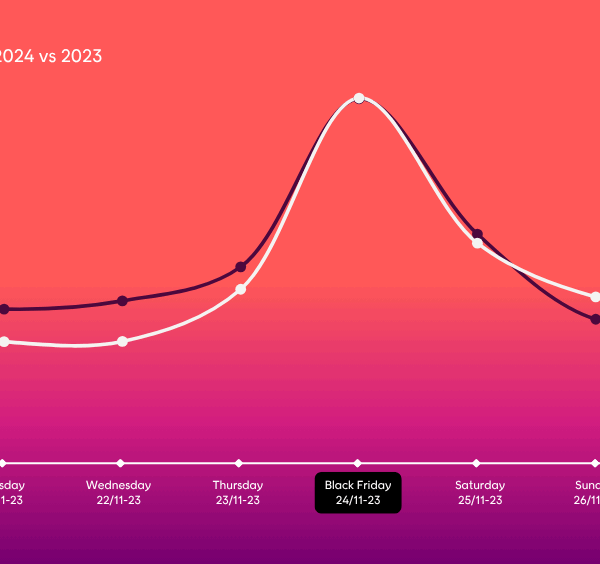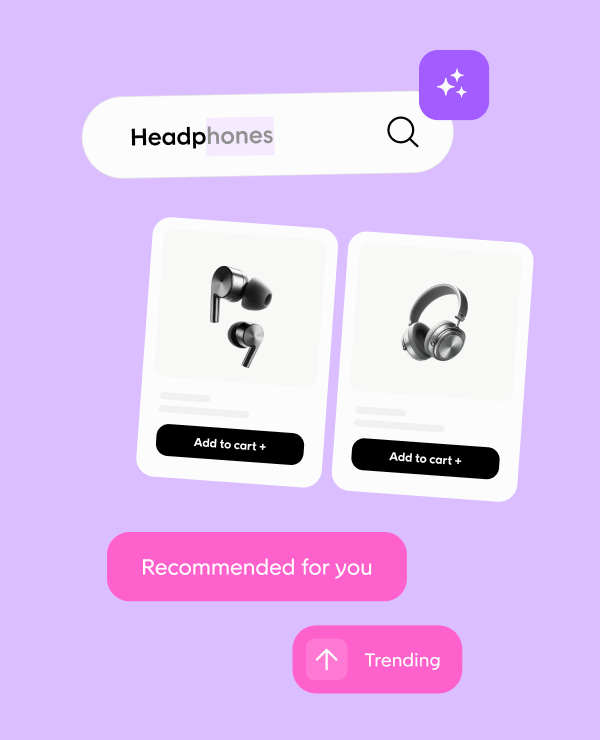Retail marketing challenges: A survival guide for modern retailers
Retailers today face a long list of challenges: unpredictable supply chains, fragmented customer data, rising ad spend, and the growing gap between what customers expect and what’s realistic to deliver.
But the opportunities haven’t disappeared, they’ve just moved.
You’ll learn about the biggest pain points in retail marketing today and how modern retailers can navigate them with smarter strategies, better tools, and a renewed focus on customer experience.
Short on time? Here are the highlights:
- Customers expect more. They want fast, personal, and seamless experiences across all channels, especially in-store and online.
- Retail media and first-party data are giving marketers more control and better returns, if used right.
- Loyalty programs and personalization help maintain customer loyalty, but only if you’re using real customer data, not guesswork.
- Physical stores still matter. The most successful brands are blending digital and brick-and-mortar experiences.
- Supply chain disruptions and inventory issues are still a threat. Better planning and predictive tools reduce lost sales.
- Trust is everything. From data privacy to marketing messages, transparency builds long-term customer relationships.
These takeaways all point to a common theme: the rules of retail are changing fast, and not all brands are keeping up. Here’s why…
The retail industry is under pressure
Retailers today are navigating a perfect storm of overlapping challenges—from economic strain to changing customer behavior. These aren’t just short-term bumps; they’re reshaping how the entire sector operates.
Raw material costs are rising
With inflation and global instability, raw material costs have increased across categories. That puts pressure on profit margins, especially for retailers trying to stay competitive on pricing without sacrificing quality or service.
Supply chains remain unpredictable
Even in 2025, supply chain disruptions haven’t fully stabilized. Delays in shipping, logistics bottlenecks, and unpredictable demand patterns continue to create gaps in inventory. That leads to missed sales opportunities and frustrated customers.
Ad spend is going up, but returns are going down
Retailers are spending more to get the same (or fewer) results. Traditional advertising channels aren’t delivering like they used to, and rising competition for digital ad space is pushing costs even higher. Without more targeted strategies, proving marketing ROI becomes more challenging.
Customers expect more than ever
Consumer expectations have shifted. Shoppers now expect fast delivery, seamless online experiences, helpful in-store support, and consistent messaging across every touchpoint. If even one part of the journey falls short, it can impact brand loyalty.
Data is siloed and hard to act on
Many retailers still rely on disconnected tools across ecommerce, CRM, POS, and marketing systems. This makes it nearly impossible to get a full view of customer behavior or act quickly on new trends. Without integrated, real-time insights, decision-making is slow and often based on guesswork.
Without connected data, even the best marketing strategies fall flat. You might be investing heavily in ads or email campaigns, but without a clear picture of your customers, those efforts miss the mark.
That’s exactly why traditional advertising isn’t enough anymore, and why it’s time for a new approach.
Why traditional advertising no longer works on its own
The retail sector is still spending heavily on advertising, but relying on traditional channels alone no longer delivers the results it once did. The way customers shop has changed, and so has their response to marketing.
To stay competitive, retailers need to move beyond broad campaigns and focus on more data-driven, personalized strategies that reflect current consumer behavior.
Here are four reasons why traditional advertising isn’t cutting it anymore and what retailers should focus on instead:
1: Marketing messages are getting lost in the noise
Traditional advertising, TV, print, radio, still has a place, but it can’t carry the full weight of your retail marketing strategy. Customers are bombarded with ads daily, and generic messaging no longer stands out.
Instead, what moves the needle are marketing strategies that feel relevant, timely, and personalized across multiple channels.
2: Consumer expectations are driving the shift
Today’s shoppers expect more than just a good deal. They want meaningful interactions and consistent experiences, whether they’re browsing online, visiting a brick-and-mortar store, or checking out on a mobile app.
Retailers who fail to meet these consumer expectations risk losing out to competitors who’ve adapted their approach.
3: Digital marketing is essential, but needs to be smarter
Investing in digital marketing across social media channels, email, and ad platforms requires a strategic approach. This means utilizing consumer data and first-party data to tailor content, offers, and timing based on actual customer behavior.
Retailers that lean into data analytics and predictive tools can better understand what customers want and deliver it before a competitor does.
4: Disparate data leads to disconnected journeys
Too often, disparate data across platforms creates fragmented experiences. A customer might click on an ad, browse your website, and walk into a store—but without connected insights, those touchpoints feel disjointed.
To build customer trust and drive customer retention, your systems and teams need to work together to create a unified customer journey.
Disconnected journeys don’t just frustrate customers, they cost you revenue, repeat business, and loyalty. The fix? Smarter use of customer data that goes beyond old-school targeting.
Let’s look at how retail media networks and first-party data are changing the game.
Retail media networks and first-party data: A smarter way to reach your audience
Retailers are sitting on a goldmine of data, and now, many are realizing it’s the key to regaining control of their marketing performance. With the decline of third-party cookies and tighter data privacy regulations, first-party data is becoming one of the most valuable assets in retail marketing.
Retail media networks take this a step further, turning a brand’s own platforms into high-performing ad spaces powered by real customer insights.
This isn’t just a trend, it’s a response to real shifts in how advertising works. Here’s how retail marketers are using first-party data and retail media networks to adapt:
The cookie is crumbling, and retail media is rising
With third-party cookies on their way out, tracking users across the web has become more difficult. That’s led to a surge in interest around retail media, which lets retailers use first-party data to reach shoppers directly on their own terms.
“One reason for the rapid rise of retail media is the decline of third-party cookies, which has made it harder for advertisers to track consumers across the web. Retail media solves this by using first-party data collected directly from shoppers’ purchases and behaviors,” explains Björn Karlström, Portfolio Product Manager at Voyado.
First-party data leads to better ad performance
Retailers already collect large volumes of customer data through loyalty programs, ecommerce platforms, and in-store purchases. Unlike third-party sources, this data is owned, privacy-compliant, and far more accurate.
Used correctly, it powers highly relevant marketing messages, improves ad spend efficiency, and helps brands attract customers with content that aligns with real consumer behavior.
Predictive analytics turns data into action
Beyond basic targeting, retailers are now applying predictive analytics to their first-party data to understand future customer trends, personalize outreach, and reduce lost sales.
This shift toward actionable insights gives teams a real advantage, not only in campaign performance but also in decision-making across the business.
Retailers that make the most of their first-party data aren’t just improving campaign performance—they’re creating more relevant, trusted, and profitable experiences across the board.
But digital strategy alone isn’t enough. Physical stores still play a critical role in shaping the customer experience, especially when they’re integrated into your broader marketing and loyalty efforts.
In fact, according to Voyado’s Retail Radar 2025, online retail saw a 3.7% decline in 2024, even as overall consumer spending increased. It’s a clear sign that shoppers still value in-person experiences—and expect brands to deliver a seamless blend of physical and digital touchpoints.
For a deeper dive into this shift—and what it means for the future of retail—you can download the full Retail Radar 2025 report here (PDF).
The comeback of physical stores: Blending brick and mortar with digital
Physical retail is far from dead—it’s being redefined. As ecommerce growth levels out, many retailers are rediscovering the value of in-person shopping experiences. But the key isn’t to choose between online and offline. It’s time to connect both.
Below are three ways physical stores are becoming an essential part of modern retail marketing, with practical takeaways for brands that want to lead, not lag.
Physical stores are powerful loyalty builders
Customers may browse online, but they often convert and build long-term loyalty in person. Touching products, speaking to staff, and experiencing a brand in a physical setting creates emotional stickiness that digital alone can’t replicate.
For direct-to-consumer brands, opening pop-ups or permanent stores isn’t just about sales, it’s about relationship-building.
Pro tip:
We’ve found that retailers who integrate loyalty data across online and in-store channels are better equipped to recognize high-value customers and personalize offers in real time. It’s not just about rewards, it’s about relevance.
In-store experiences must reflect online expectations
Customers now walk into stores expecting the same speed, personalization, and accuracy they get online. They want to know what’s in stock, see tailored promotions, and get product recommendations based on past purchases—even at a physical register.
If the offline experience lags behind, it can undermine trust and brand perception.
Pro tip:
We recommend giving store teams access to real-time customer insights, whether that’s purchase history, loyalty tier, or preferences. Empowered staff are the fastest way to turn in-store interactions into long-term relationships.
Omnichannel marketing drives measurable growth
The most successful retailers don’t separate ecommerce from physical retail. Instead, they unify channels into a single retail marketing strategy that’s driven by customer behavior, not department silos.
This kind of alignment improves customer retention, avoids lost sales, and helps brands respond faster to shifting consumer preferences.
Pro tip:
We advise mapping the whole customer journey across all touchpoints, then identifying where disjointed systems or messaging cause drop-off. Unified data and shared KPIs across teams make omnichannel efforts far more scalable.
Blending physical and digital retail isn’t just a nice-to-have anymore; it’s the baseline for meeting modern customer expectations.
However, even with a seamless shopping journey, what truly sets brands apart is how well they understand, engage with, and reward their customers.
That’s where personalization and loyalty come into play.
Personalization, loyalty programs, and the fight for customer trust
Loyalty isn’t earned through points or discounts alone anymore. Customers are more selective, more informed, and quick to disengage from brands that treat them like just another email address in the system.
To build lasting relationships, retailers need to go deeper by creating personalized, emotionally resonant experiences rooted in real data and mutual trust.
Loyalty is no longer just about discounts
The most effective loyalty programs today don’t focus on rewards alone. They focus on relevance. Customers want to feel seen and understood, whether they’re engaging online, in-store, or somewhere in between.
“At By Malene Birger, we believe loyalty is about creating meaningful connections with our customers. It’s not just about rewards or discounts—it’s about inspiring them through personalized experiences, storytelling, and exclusive opportunities that reflect the essence of our brand – and rewarding them at the right moment.”
— Laufey Lúðvíksdóttir, CRM and Loyalty Specialist at By Malene Birger
Retailers that understand this shift are redesigning their loyalty efforts to prioritize emotional engagement, exclusive content, and personalized timing over blanket offers.
Customer data should power every interaction
Strong personalization isn’t possible without strong data. And yet, many brands still struggle with disconnected systems, missing insights, or too much noise. The key isn’t just collecting data but using the right data at the right moment.
Here are some of the first-party data sources that matter most:
- Purchase history (online and in-store)
- Email and campaign engagement
- Loyalty tier and rewards usage
- Browsing behavior and abandoned carts
- Preferred channels and shopping frequency
Retailers who activate this data across their marketing tools are better equipped to deliver timely, relevant messaging that drives loyalty instead of fatigue.
Trust is the loyalty multiplier
Even the most personalized experience can backfire if it feels intrusive or irrelevant. Shoppers are becoming increasingly aware of how their data is used—and quick to disengage if something feels off.
Building loyalty today means being transparent, respectful, and thoughtful with every interaction. It means asking, “Does this message help the customer, or just the brand?” When customers feel respected, they stay longer and spend more.
Even with strong personalization and loyalty programs in place, many retailers still hit a wall, not because of strategy, but because of systems. Disconnected tools and scattered data make it hard to act fast, adapt to trends, or see the full picture.
Let’s talk about what’s holding teams back and what to do about it.
Data overload and the problem with disparate systems
Retailers have no shortage of data. The real problem is making sense of it.
With insights coming from ecommerce platforms, POS systems, CRM tools, marketing platforms, and loyalty programs, it’s easy for teams to get overwhelmed. And when that data lives in silos, it’s almost impossible to act on it in real time.
This leads to reactive decisions, slow campaign launches, and missed opportunities, especially when customers expect fast, relevant, and consistent interactions.
Why disconnected systems are so common
Many retail organizations have grown quickly or layered in new tech over time. That often means patching systems together instead of building an integrated stack. The result? Valuable data that’s locked away in separate tools, managed by different teams, with no single source of truth.
This not only slows down marketing, but it creates gaps in the customer journey that impact everything from inventory planning to ad performance.
The cost of inaction
When systems don’t speak to each other, retailers miss out on:
- Understanding real-time consumer behavior
- Spotting trends across multiple channels
- Reducing lost sales due to poor inventory management
- Personalizing messaging based on actual behavior, not assumptions
- Acting on customer feedback and engagement signals
What’s worse is that many teams don’t even realize how much opportunity is lost until they compare outcomes with more integrated competitors.
Where to go from here
Fixing data silos is a strategic priority. Retailers that build shared visibility across departments and platforms are better equipped to adapt quickly, deliver stronger experiences, and scale what’s working.
Pro tip:
Before investing in new tools, map out how your existing systems connect or don’t. We’ve seen retailers make the biggest gains not by adding more tech, but by aligning teams around the data they already have. Clean, connected insights are what turn activity into impact.
Inventory challenges are costing you more than lost sales
Inventory issues might seem like a backend problem, but they have real, lasting effects on customer loyalty, brand trust, and overall business growth. From supply chain disruptions to misaligned forecasting, even small breakdowns in planning can ripple through your entire retail operation.
1. Stock-outs don’t just lose sales, they lose trust
When customers see “out of stock” messages or experience delivery delays, it sends a clear message: this brand isn’t reliable. And in a crowded market, most shoppers won’t wait around; they’ll go elsewhere.
Frequent stock-outs also undermine your marketing efforts. Promoting products that aren’t available leads to wasted ad spend, higher bounce rates, and a damaged customer experience. This is lost revenue and momentum.
2. Overstocking eats margin and weakens your strategy
Overcorrecting for stock-outs often results in excess inventory. That might solve short-term availability, but it creates new problems: tied-up cash flow, steep discounts, and a weakened pricing strategy.
It also limits your retail marketing strategy. You end up promoting products that aren’t aligned with customer preferences just to move inventory. This erodes engagement and can condition customers to wait for markdowns instead of buying at full price.
3. Real-time visibility enables smarter marketing
Retailers who connect inventory management data with marketing and customer insights are better equipped to act fast, and act well. When campaigns align with what’s actually in stock, across both physical stores and ecommerce, shoppers get a smoother, more trustworthy experience.
Better still, layering in predictive analytics and first-party data helps retailers forecast demand, tailor offers, and plan campaigns that meet both operational goals and consumer expectations.
What we recommend:
Inventory can be a strategic lever for customer retention and marketing performance. Here’s how we advise retailers to tighten the connection between stock and strategy:
Audit where inventory and marketing are disconnected
Start by identifying where your campaigns are misaligned with actual stock levels, both online and in-store. This includes promoted products that are low or out of stock, or customer segments receiving irrelevant offers.
Bring supply chain and marketing data into the same room
Weekly syncs between marketing, ecommerce, and operations teams can surface issues early. Shared dashboards help all teams work from the same set of numbers.
Use historical and behavioral data to forecast smarter
Look beyond seasonality. Use first-party data (loyalty activity, browsing behavior, purchase cadence) to forecast demand more accurately and plan campaigns around what people want.
Don’t wait for perfect systems—start with visibility
You don’t need a full-stack overhaul to get started. Even simple alignment between your point of sale (POS), CRM, and email platforms can reveal opportunities to reduce lost sales and improve timing.
Inventory issues might be the most visible cracks in a retailer’s operation, but they’re just one piece of a bigger shift. As customer expectations evolve and new tools emerge, the way retailers approach marketing is changing rapidly.
So what’s next?
What the future of retail marketing looks like
The next year won’t be defined by one single retail trend, but shaped by how well retailers adapt to constant change. The brands that succeed won’t just invest in new tools; they’ll rethink how they connect the dots between data, experience, and trust.
Here’s what we expect to define modern retail marketing over the next 12–18 months:
Data privacy becomes a brand differentiator.
Customers aren’t just aware of how their data is used; they care. Brands that clearly communicate what they collect, why, and how it benefits the customer will earn more trust (and loyalty) than those that rely on vague cookie notices or fine print.
In-store and online loyalty fully merge.
Customers want to be recognized and rewarded wherever they shop, not just online. Smart retailers will connect in-store activity with digital behavior to offer seamless, relevant loyalty experiences across all channels.
Ad platforms shift toward first-party data.
With third-party cookies disappearing, retailers will rely more heavily on their own first-party data to power campaigns. This will lead to better targeting, less wasted ad spend, and more control over the customer journey.
Emotional engagement scales—with tech in the background.
Automation will handle volume, but brands that manage to retain a human tone, through storytelling, community, and emotional relevance, will stand out. Loyalty will hinge on connection, not just convenience.
Predictive tools guide both planning and personalization.
Retailers will lean more heavily on predictive analytics to inform not only marketing decisions, but also product selection, inventory levels, and timing. The line between data and intuition will blur—in a good way.
Retail marketing becomes cross-functional by default.
The days of marketing sitting in a silo are over. The future belongs to retailers whose marketing efforts are tightly integrated with ops, ecommerce, and customer service—because that’s what it takes to deliver consistently strong experiences.
What’s clear is this: retail marketing is evolving. And while the challenges are real, the opportunities for smarter, more connected, and more human strategies have never been greater.
Over to you: Turn your challenges into opportunities
Retail marketing today requires more than good creative or the right tech stack. It demands clarity, connection, and adaptability across every part of the business.
From rising ad spend to inventory disruptions and shifting consumer expectations, the pressure is real. But it’s also a chance to reset.
Whether you’re part of a global chain or a growing direct-to-consumer brand, the goal isn’t to do everything at once but to focus on what matters most:
- building lasting customer relationships,
- using data responsibly,
- and making every campaign, product drop, and in-store interaction feel intentional.
The retailers leading the way aren’t waiting for ideal conditions. They’re working with what they have, getting cross-functional teams aligned, and making smarter decisions day by day. Start there and improve what you can see. Voyado is here to help.
FAQ: Retail marketing challenges and how to overcome them
What are the biggest retail marketing challenges today?
Some of the most common challenges include rising ad spend, supply chain disruptions, data silos, and changing consumer expectations. Many retailers also struggle to connect their physical stores and digital channels in a way that feels seamless to customers.
How can retailers use first-party data effectively?
First-party data, collected through loyalty programs, purchase history, and email engagement, can help retailers personalize campaigns, improve inventory management, and deliver more relevant marketing messages. The key is making that data accessible across teams and platforms.
Why is customer trust so important in retail marketing?
Customers today are more privacy-conscious and selective about where they spend. Clear communication around data privacy, personalization that feels helpful (not invasive), and exceptional customer service all play a role in building lasting customer trust.
What role does emotional loyalty play in customer retention?
Emotional loyalty goes beyond points and discounts. It’s about creating experiences that reflect the customer’s values and preferences. Retailers who invest in storytelling, exclusivity, and personalization tend to see stronger customer retention and long-term brand loyalty.
How do supply chain issues affect marketing?
When inventory levels are off, marketing suffers. Promoting out-of-stock items leads to lost sales and customer frustration. On the other hand, excess inventory often leads to over-discounting and wasted spend. Aligning supply chain and marketing strategies helps avoid both extremes.
What’s the best way to stay competitive in the current retail sector?
There’s no one-size-fits-all approach, but retailers that unify their data, personalize across channels, and act quickly on consumer behavior are in the best position to grow. Staying close to your customers—and agile behind the scenes—is the smartest way to move forward.










